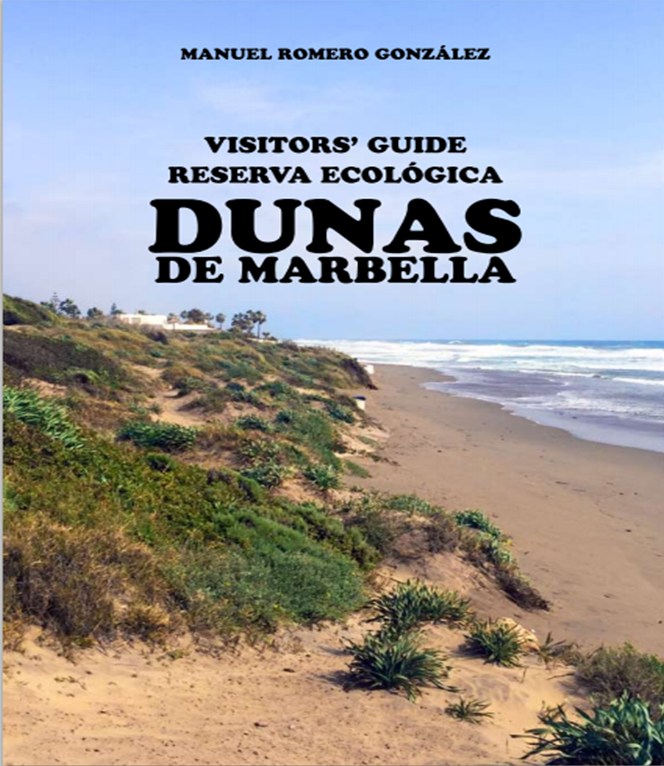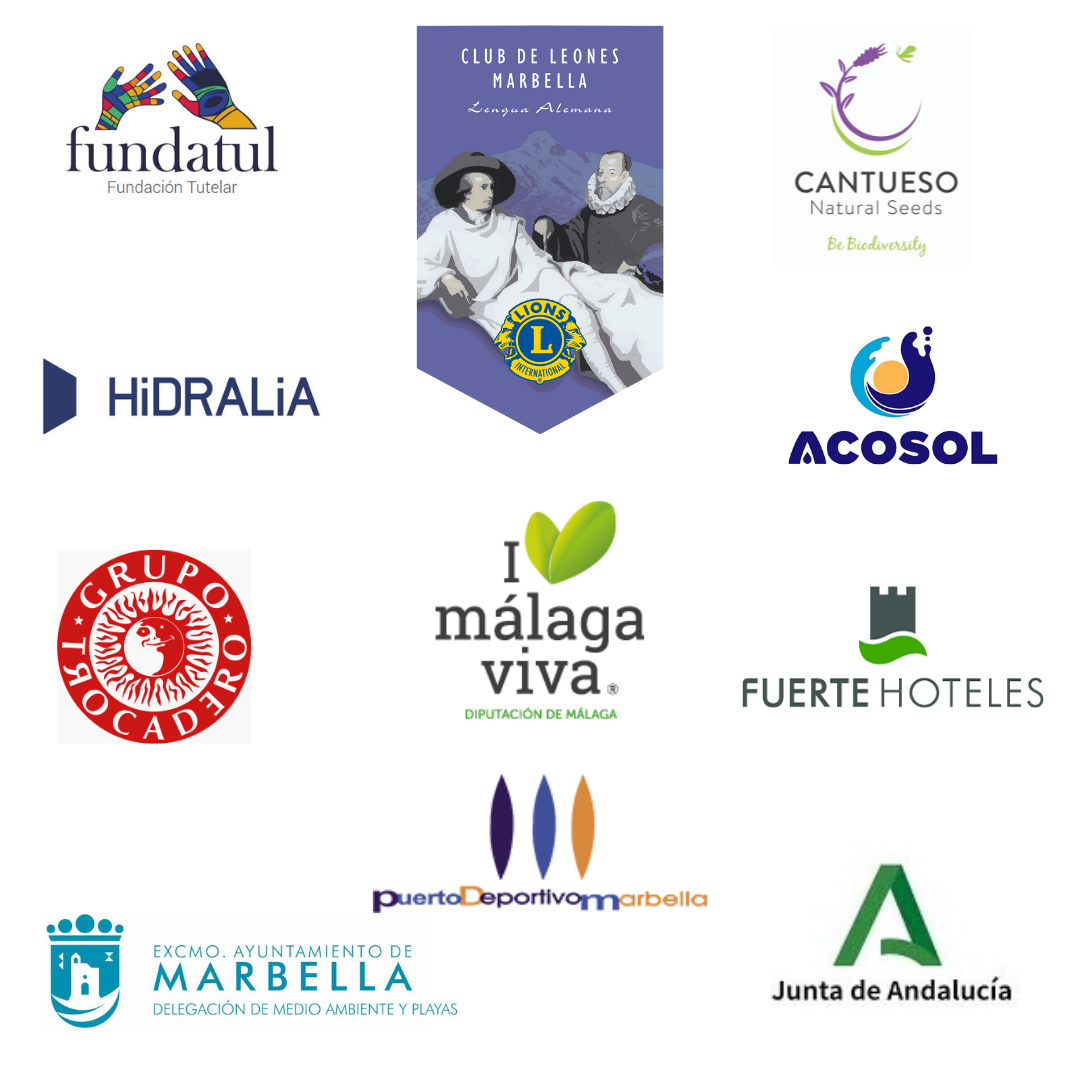Visitor’s Guide - Ecological Reserve-Dunas de Marbella
27th April 2022 – PRODUNAS MARBELLA HELD A PRESS CONFERENCE TO PRESENT THE BOOK “DUNAS DE MARBELLA”
The natural wealth contained in the dune environment on our coast is incredible. The ProDunas Marbella Association has summarised it in a guide book of just 200 pages in an attempt to bring it closer to the general public. Now that the pandemic is over, we are relaunching this essential reference work so that our heritage can be better understood.
Hidralia has been kind enough to sponsor a run of 500 copies in English, since the previous one was run out during the pandemic.
Presentation – Visitor’s Guide – Walking through the Ecological Reserve – Dunes of Marbella
The coast of Marbella has always been considered one of the most beautiful environments on the entire coast of Malaga, embellished as it is with an especially rich background of natural resources and accompanied by a diverse heritage treasured throughout history as a reflection of the evolution of different Cultures and events.
This set of natural and cultural values remained almost untouched, with little degradation, until well into the twentieth century. Then in the sixties, the discovery by tourism of the charms of this land brought about a change to the welfare of the entire coastal area. It went from traditional agriculture, livestock, fishing or hunting activities to a town planning which would generate greater economic benefits for landowners and developers.
The development of sprawling urban development and the absence of adequate legislation, in addition to the lack of a vision of the future by politicians and technical staff alike, made it possible to carry out a massive occupation of the coast, with the inevitable effect on many of those values that had made the Malaga coastline unique. Thus, the extensive beaches that once reached from Marbella to the boundary with Mijas, were gradually reduced to small sections, separated from each other and overwhelmed by nearby construction, and the pressure of thousands of visitors and their vehicles.
It was the determination of a nucleus of residents of these dunes, mostly grouped together in the Produnas Association, which promoted a decisive and combative support for the conservation of these small remaining dune. They convinced the Town Council and subsequently attained the support of the Junta de Andalucía (the Government of the Autonomous Region of Andalucía), and got it declared an Ecological Reserve thus under the protection of Law 8/2003 of October 28, on 18th September, 2015. Since then, the Technical Plan of the area has been developed with greater or lesser luck (and budget). This TP establishes what has to be done to effectively achieve the conservation and improvement of the values preserved in the area for the enjoyment and the enlightenment of the local population and the visitors.
In order to disseminate and report on these values to a wider audience, the opportunity to put together a small Guide was considered. The idea was to collect the most significant data of the reality of the Ecological Reserve, which would then serve as a rallying point emphasising the reality of these beautiful areas of our coastline, boosting the will for its conservation and protection. This is how the content of this book has been designed. Together with the most significant data on their biodiversity and cultural resources, suggestions as to places to visit are also incorporated to help one get to know each and every one of the protected dune units, on very different moments in their development and how they are used by the various people involved.
Thus, with an individualised view of each of the dunes and the support of photographic material, their individual values are displayed, with identification of the existing resources and their location.
This initial objective of dissemination and information is complemented by the deepest of awareness of the attempt to achieve both social and institutional support for the Ecological Reserve; unfortunately, the Declaration does not necessarily imply success in its conservation. This requires permanent collaboration between the institutions (Marbella Town Hall, Coastal Demarcation and Territorial Delegation of Environment) and the Produnas Association as the main supporter of their protection, together with the various groups whose interests are affected by the Declaration (especially Communities of Owners and Business Associations); this is the only way that the dangers which continue to threaten the Ecological Reserve can be reversed and the sustainability of these small natural jewels and their enjoyment by the people of Marbella and visitors alike can be safegu
GRATITUDE
We dedicate this Visitor’s Guide to our faithful partners and supporters; to the countless volunteers and participants who always come to help us with the dune conservation work; to the schoolchildren who have sponsored a dune environment and taken care of it during the school year; to researchers and professors from the University of Malaga’s multiple disciplines in the fields of Conservation Biology; to university students, who came to visit us from other Communities and even from Michigan (USA); to Marbella Town Hall and its Environment Delegation; to the Ministry of the Environment and to the Demarcation of Coasts – for the Mediterranean Coast of Andalusia.
Everyone has taken part in one way or another, supporting ProDunas. In all these years we have learned to love and respect the enormous Natural Heritage that exists on the coast of Marbella; we have been enriched by getting to know the beautiful biodiversity of the flora and fauna that exist in the different dune ecosystems between Marbella East and Cabopino and we have been captivated forever.
We intend with this Visitor’s Guide, that others follow in our footsteps to ensure that this valuable Natural Dune Heritage is never lost.
SHORT CURRICULUM of Mr. Manuel ROMERO GONZÁLEZ
Mr. Romero is a biologist, a specialist in Protected Natural Spaces (Autonomous University of Madrid) and in the Restoration of Degraded Spaces (Polytechnic University of Madrid). He has a Master’s degree in Urban Planning and the Environment and in Environmental Education (UNED). He has a Diploma in Environmental Impact Assessment (Ministry of Public Works), and is a UNESCO Consultant in the ÍNSULA Program (the International Scientific Council for Island Development).
He is a both a National Civil Servant (he was on the staff of the 9th Regional Inspectorate of ICONA 1982-1986), and a Junta de Andalucía one (as head of the Department of Geodiversity and Biodiversity in the Delegation of the Environment in Malaga, 1986-2017). He was Secretary of the Provincial Council of the Environment (1992-1996).
He has carried out his work in various areas of natural resource conservation, natural spaces and environmental protection. He is the author of studies prepared so that these Natural Parks could be so declared: the Natural Park of Sierra de Las Nieves, the Natural Areas of Malaga and he is co-author of the studies on those of the Sierra Nevada, Cazorla Segura and Las Villas. He was curator of the Natural Sites of the Province (El Torcal, Gaitanes, the Estuary of the Guadalhorce, the Maro Cliffs, Sª Crestellina, Los Reales) (1989-99) and the Natural Reserves of the Lagoons of Archidona (1989-1994), and he was responsible for the management of the Ecological Reserves of the Province (Playas de Manilva, Dunas de Marbella, the Basins of the Turón and Guadalteba).
He was the coordinator of the Seminars on Nature Programs in the Province of Malaga (1979-82). He was Provincial Director of Forest Fires (1987-91) and Technical Head of Coordination and Extinction of Forest Fires (1987-1991 and 1993-1997) and he was in charge of the Recovery Centre for Endangered Species.
As a lecturer, he has worked as an associate professor in didactic centres (1979) and has taught various training courses in conservation, management of open spaces and natural resources in the Esculapio and Forge XXI Foundations, in Trade Union organizations (CSIF, UGT ), as well as in the Administration itself (Andalusian Institute of Public Administration).
Author of several research papers on Conservation Biology, he has published numerous informative books on the Natural Areas of Malaga (Visitor’s Guide to El Torcal de Antequera, Vertebrate Fauna of El Torcal de Antequera, El Hombre and El Torcal de Antequera, Los Ardales Reservoirs, Sierra Crestellina, Maro-Cerro Gordo Cliffs, Los Gaitanes-El Chorro: conocimiento básicos, Visitor’s Guide to the Sierra de La Utrera, Canuto de La Utrera and Baños de la Hedionda, El Pinsapo: the Andalusian Fir ( two volumes), The Ecological Reserve of the Beaches of Manilva, among others.
He has taken part in various development work teams at Provincial level (Special Plan for the Protection of the Physical Environment) and at National level (Planning and Management of the Biosphere Reserve Network), etc.
SUMMER TIME – TIME TO ENJOY READING THE “VISITORS’ GUIDE TO THE DUNES OF MARBELLA”


We are still giving away copies of the “Visitors’ Guide” to accompany walks through the dunes of the Ecological Reserve-Dunes of Marbella.
Remember, you can get a copy both in the Tourist Offices of Marbella and San Pedro as well as from ProDunas directly > link: https://produnas.org/en/contact.
We have copies in Spanish, English and German.
It is an enjoyable read and it helps you get to know the different dune ecosystems.
Do you want to receive our Newsletter?
Do you want to become a member or be our friend of the dunes?
Asociación ProDunas Marbella
La Asociación trabaja incesantemente en defensa y preservación de los singulares ecosistemas aún existentes en los entornos naturales con dunas en la Provincia de Málaga; impulsa la protección de su flora autóctona y pequeña fauna silvestre; fomenta la recuperación, rehabilitación y conservación de la interesante biodiversidad en las zonas dunares del municipio de Marbella.
+34 609 600 706
comunicacion@produnas.org

